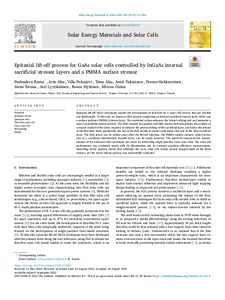Epitaxial lift-off process for GaAs solar cells controlled by InGaAs internal sacrificial stressor layers and a PMMA surface stressor
Ramu, Prabudeva; Aho, Arto; Polojärvi, Ville; Aho, Timo; Tukiainen, Antti; Hakkarainen, Teemu; Reuna, Jarno; Lyytikäinen, Jari; Hytönen, Roosa; Guina, Mircea (2022-12)
Ramu, Prabudeva
Aho, Arto
Polojärvi, Ville
Aho, Timo
Tukiainen, Antti
Hakkarainen, Teemu
Reuna, Jarno
Lyytikäinen, Jari
Hytönen, Roosa
Guina, Mircea
12 / 2022
111982
Julkaisun pysyvä osoite on
https://urn.fi/URN:NBN:fi:tuni-202209197148
https://urn.fi/URN:NBN:fi:tuni-202209197148
Kuvaus
Peer reviewed
Tiivistelmä
Epitaxial lift-off (ELO) techniques enable the development of thin-film III–V solar cell devices that are flexible and lightweight. To this end, we report an ELO process employing an internal sacrificial stressor layer (ISSL) and a surface polymer (PMMA) stressor layer. The combined action enhances the lateral etching rate and promotes a more controllable release process. The ISSL consists of quantum well-like GaInAs heterostructures that enable an accurate control of the stress required to enhance the lateral etching of the sacrificial layer, and hence the release of the thin film. More specifically, the use of the ISSL results in about 5-fold faster etch rate of the AlAs sacrificial layer. The ISSL layers can be etched away after the lift-off. Likewise, the PMMA surface stressor, which serves also as a sacrificial intermediate transfer layer, can be easily removed. The proof-of-concept device demonstration of the enhanced ELO technique was made by fabricating single-junction GaAs solar cells. The solar cell performance was evaluated under AM1.5d illumination and by external quantum efficiency measurements. Modelling based analysis shows that although the GaAs solar cell would require improvement of the front contact, yet the novel release process was successfully validated.
Kokoelmat
- TUNICRIS-julkaisut [16944]
